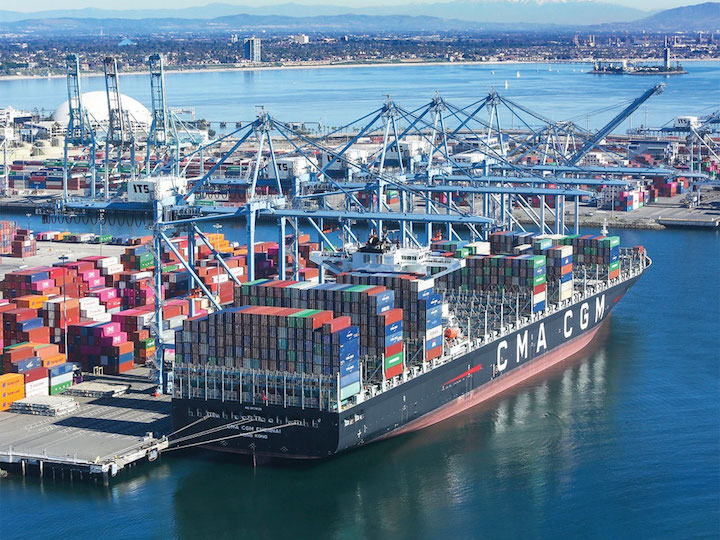In a bold move to end the gridlock at the Ports of Los Angeles and Long Beach, the two ports announced that they will assess ocean carriers $100 per container per day surcharges for import containers that are not moved off marine terminals after specified time periods.
This action will put pressure on ocean carriers, big import shippers and the two railroads serving the two ports to move containers off the congested Southern California docks.
- Truck moves - In the case of “containers scheduled to move by truck, ocean carriers will be charged for every container dwelling nine days or more.”
- Rail moves - For containers “moving by rail, ocean carriers will be charged if the container has dwelled for three days or more.”
Beginning November 1st, the ports will charge ocean carriers with cargo in those two categories $100 per container, increasing in $100 increments per container per day, the announcement said.

SSA says terminals and longshore workers not to blame
Ed DeNike, president of SSA containers, operates 8 terminals on the West Coast. SSA represents 25% of the West Coast ports’ man-hours and SSA operates three terminals in Southern California including at the Port of Long Beach.
DeNike has been saying for months that container terminal operators and longshore workers have been the target of a false narrative that blames dockworkers for a congestion crisis that they have no control over and did not cause.
DeNike told the International Propeller Club convention on October 13th: “What we are seeing is that the containers are not being picked up at our off-dock facilities or at our terminals at the waterfront.”
On the issue of more night hours and 24-hour service at terminals: “We don’t believe that more gate hours are going to solve the problem,” he said.
DeNike explained that the congestion crisis began in 2020 “by the fact that the railroads (Burlington Northern Santa Fe and Union Pacific) simply could not keep up with the volume that was coming through the West Coast.”
DeNike heard that similar problems with rail service were happening at other Los Angeles and Long Beach marine terminals:
“The containers that were destined to go intermodal (via rail) were piling up in the thousands. They were taking up room and creating havoc among all of us … The railroads have done a little better recently, but it’s still an issue.”
Before the pandemic-induced import surge began in mid-2020, containers for Southern California delivery sat on container terminals an average of four days, while containers destined for Union Pacific and Burlington Northern Santa Fe trains headed for Chicago and other Midwest destination dwelled an average of less than two days: “Those numbers have increased significantly, making it difficult to clear cargo off the terminals and bring in ships at anchor,” the announcement said.
One possible outcome of the surcharge policy might be for ocean carriers to shift ships destined for Southern California further north to discharge containers at the Ports of Oakland, Seattle and Tacoma.

Back to Oakland?
In effect, ocean carriers shifted 40% of the monthly vessel traffic out of the Port of Oakland in August, according to the Port.
As of October 25th, the Port reported no vessels are waiting at anchor waiting to unload.
In an October 19th, press release, the Port of Oakland reported:
“There’s no congestion at the Oakland seaport, and we’re ready for more business,” declared Port of Oakland Maritime Director Bryan Brandes. “We need ocean carriers to reinstate services in order to stabilize the supply chain, and our import and export partners echo this sentiment.”
Oakland said shipping lines can help ease the gridlock by steering ships back to Oakland. Several ocean carriers omitted Oakland in recent months, the Port said. It explained that excessive Southern California delays necessitated immediate return of some ships to Asia without stopping in Oakland.
According to the Port, 54 vessels stopped in Oakland last month. It was the lowest vessel call total since 2015, the Port said.
The Port said it expects service restoration to begin next month as supply chain congestion grinds on elsewhere.
In the meantime, harbor truckers are reporting skyrocketing trucking rates and delays moving containers between the Southern California ports and Northern California shippers as a result of the cutbacks in ocean carrier sailings to the Port of Oakland.
The cutbacks have also added to truck congestion on California’s I-5 freeway corridor linking Southern California to Northern California.
Seroka and Cordero explain surcharge
The announcement quoted Port of Los Angeles Executive Director Gene Seroka as stating: “We must expedite the movement of cargo through the ports to work down the number of ships at anchor … Approximately 40% of the containers on our terminals today fall into the two categories. If we can clear this idling cargo, we’ll have much more space on our terminals to accept empties, handle exports, and improve fluidity for the wide range of cargo owners who utilize our ports.”

Port of Long Beach Executive Director Mario Cordero noted: “With the escalating backlog of ships off the coast, we must take immediate action to prompt the rapid removal of containers from our marine terminals … The terminals are running out of space, and this will make room for the containers sitting on those ships at anchor.”

“I support the actions taken by the Ports of Los Angeles and Long Beach today to charge ocean carriers for lingering containers on marine terminals. These actions aim to expedite the movement of goods and reduce congestion in our ports,” said John D. Porcari, Port Envoy to the Biden-Harris Supply Chain Disruptions Task Force.
Surcharge fees collected from ocean carriers for delays will be re-invested by the two ports for programs designed to enhance efficiency, accelerate cargo velocity, and address congestion impacts throughout the San Pedro Bay.
The policy was developed in coordination with the Biden-Harris Supply Chain Disruptions Task Force, U.S. Department of Transportation and multiple supply chain stakeholders, according to the announcement.
On October 25th, the Marine Exchange of Southern California reported: “164 total ships in port LA/LB including 107 at anchor or hold areas and 57 at berths. Of the 164, 102 are container ships including 73 at anchor or in hold areas.”

